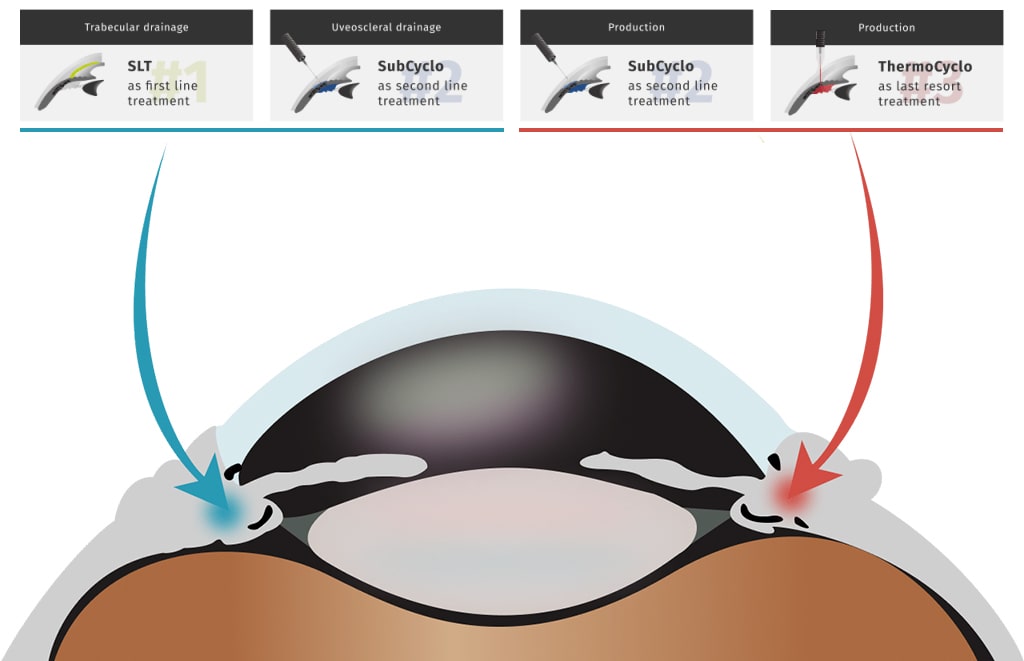Introduction to
Introduction to
Why Subthreshold Laser Should Be the Treatment of Choice for Glaucoma Patients?
A typical treatment algorithm for POA-Glaucoma has been pharmacotherapy, Argon laser trabeculoplasty, MIGS, then incisional surgery, with high risk cyclo-destructive techniques preserved for end stage with poor prognosis of visual outcomes.
Subthreshold laser therapy delivers a substantially improved risk profile and SLT is now indicated as a first-line therapy for successful management of POAG and ocular hypertension.
Today’s contemporary treatment algorithm places SLT up front with SubCyclo replacing cyclo-destruction, suitable much earlier in the disease process.
🔍 ZOOM TO VISUALIZE TREATMENTS

SLT
SubCyclo
SubCyclo
ThermoCyclo
LASER TRABECULOPLASTY: FROM ALT TO SLT…
Laser treatment of POAG and ocular hypertension has been used for decades. In the 1990s, the GLT study1 demonstrated equivalence in efficacy between Initial treatment with argon laser trabeculoplasty, (ALT), versus topical medication. However, given its associated risk profile, ALT is not considered a first-line treatment option.
Around the same time Mark A. Latina, M.D. of Tufts University, Boston pioneered the concept of selective laser trabeculoplasty (SLT).
SLT induces a biological response in lowering IOP with equivalent efficacy, but without the thermal damage and irreversible structural changes to the trabecular meshwork, intrinsic with ALT.
Subthreshold laser therapy delivers a substantially improved risk profile and SLT is now indicated as a first-line therapy for successful management of POAG and ocular hypertension2; demonstrating repeatability, while maintaining IOP at or below target over considerable time.3
Clinical References
1 The Glaucoma Laser Trial Research Group. Am J Ophthalmol. 1995;20(6):718-731.
2 Gazzard G, Konstantakopoulou E, Garway-Heath D, et al. Selective laser trabeculoplasty versus eye drops for first-line treatment of ocular hypertension and glaucoma (LiGHT): a multicentre randomised controlled trial. Lancet. 2019, Mar 9;393(10180):1505-16.
3 Ophthalmology. 2020 Apr;127(4):467-476.
LASER CYCLOPHOTOCOAGULATION: From Cyclodestruction to SubCyclo
Cyclodestruction has been a treatment option for refractory glaucoma since the 1930’s with Cyclocryotherapy among the first techniques used to partially destroy the ciliary process.
Laser Transscleral Cyclophotocoagulation, TSCPC, using a Ruby laser followed, described by Beckman et al., in 1972.
Incremental improvements in technique and technology over time have resulted in diode laser options which are safer and as effective.
Cyclophotocoagulation (ThermoCyclo) using 810nm has been demonstrated as a simple, non-invasive way to treat advanced refractory glaucoma1.
ThermoCyclo relies on continuous delivery of laser energy to destroy the ciliary body, with unavoidable collateral damage to surrounding tissue.
Complications associated with ThermoCyclo include, vision loss, chronic hypotony, sympathetic ophthalmia and phthisis bulbi.
Due the risk profile associated with Thermocyclo it is usually reserved for eyes with the poorest visual prognosis.
Subliminal Cyclophotocoagulation, (SubCyclo), based on the principle of TSCPC, demonstrates similar efficacy with a vastly improved safety profile.
SubCyclo delivers subtle laser pulses interlaced with large periods of laser off time, to avoid accumulation of heat to a destructive level.
The SubCyclo technique stimulates the ciliary body and remodels the uveoscleral pathway inducing a biological response, lowering IOP, without destructive thermal dispersion into surrounding tissue.
Recent studies have shown SubCyclo to be as effective as TSCPC with significantly less risk. SubCyclo is also REPEATABLE.
SubCyclo is an excellent alternative to medical and surgical treatment options, including MIGS and may be considered earlier in the glaucoma treatment paradigm.2 3 4
Clinical References
1 Bloom PA, Tsai JC, Sharma K, et al. “Cyclodiode.” Trans-scleral diode laser cyclophotocoagulation in the treatment of advanced refractory glaucoma. Ophthalmology.1997;104(9):1508-1519
2 Benhatchi N, Bensmail D, Lachkar Y. Benefits of SubCyclo laser therapy guided by high-frequency ultrasound biomicroscopy in patients with refractory glaucoma. J Glaucoma. 2019;28(6):535-539.
3 Lutic I, Dragne C, Filip M, et al. SubCyclo laser procedure results in patients with glaucoma. Rom J Ophthalmol. 2018;62(4):296- 299.
4 Keilani C, Benhatchi N, Lachkar Y, et al. Comparative effectiveness and tolerance of subliminal subthreshold transscleral cyclophotocoagulation with a duty factor of 25% versus 31.3% for advanced glaucoma. J Glaucoma. 2020;29(2):97-103.

